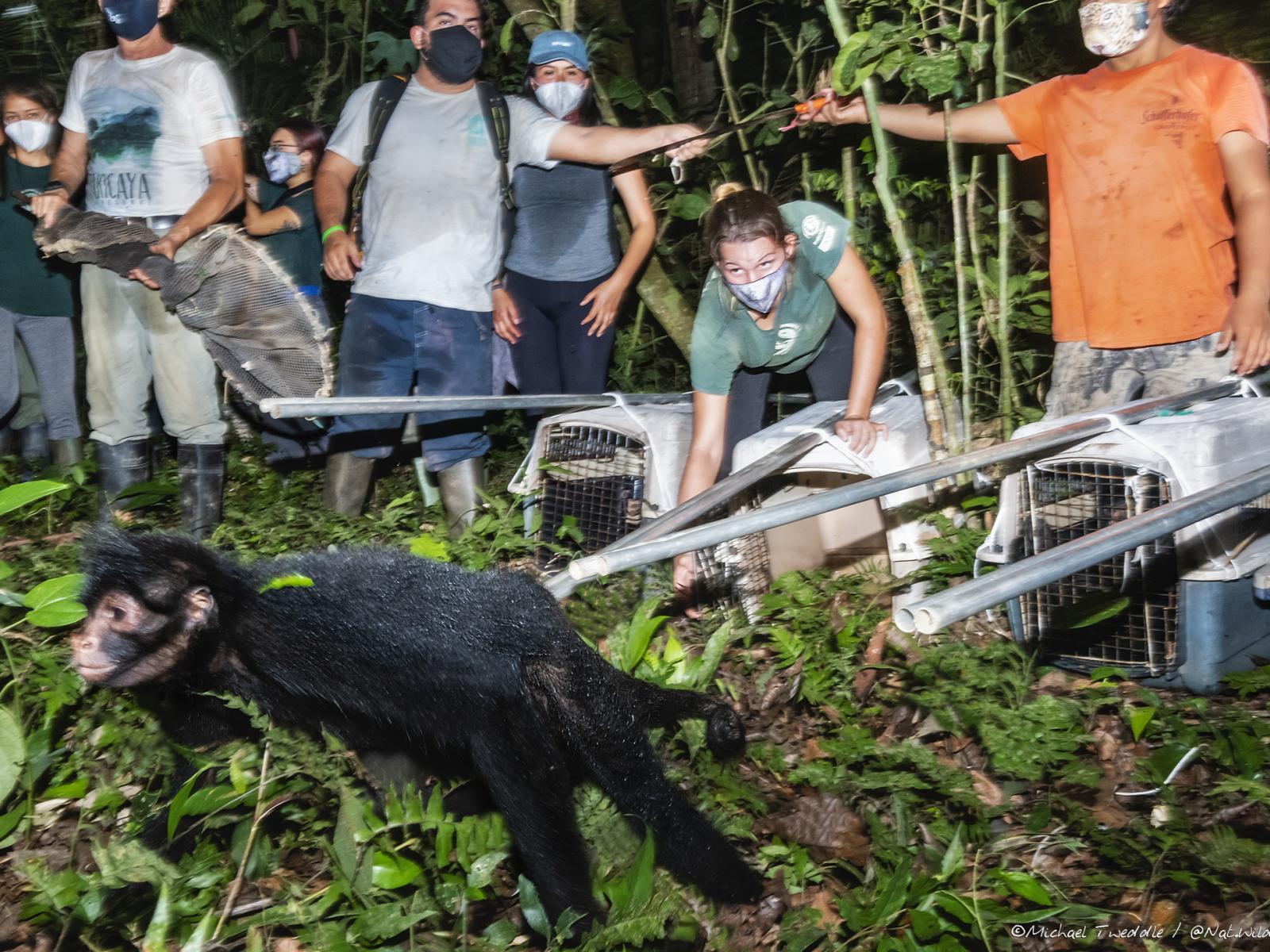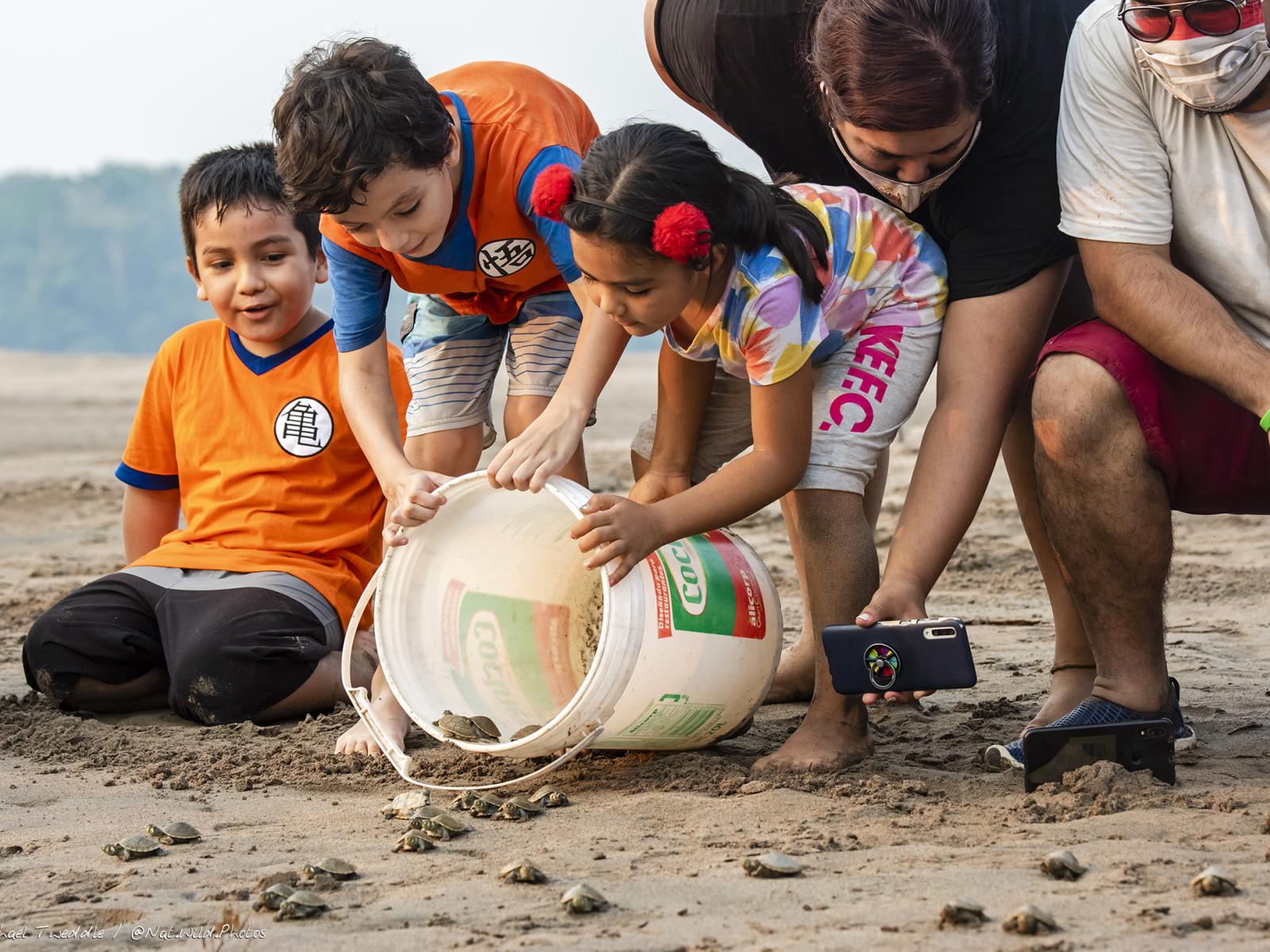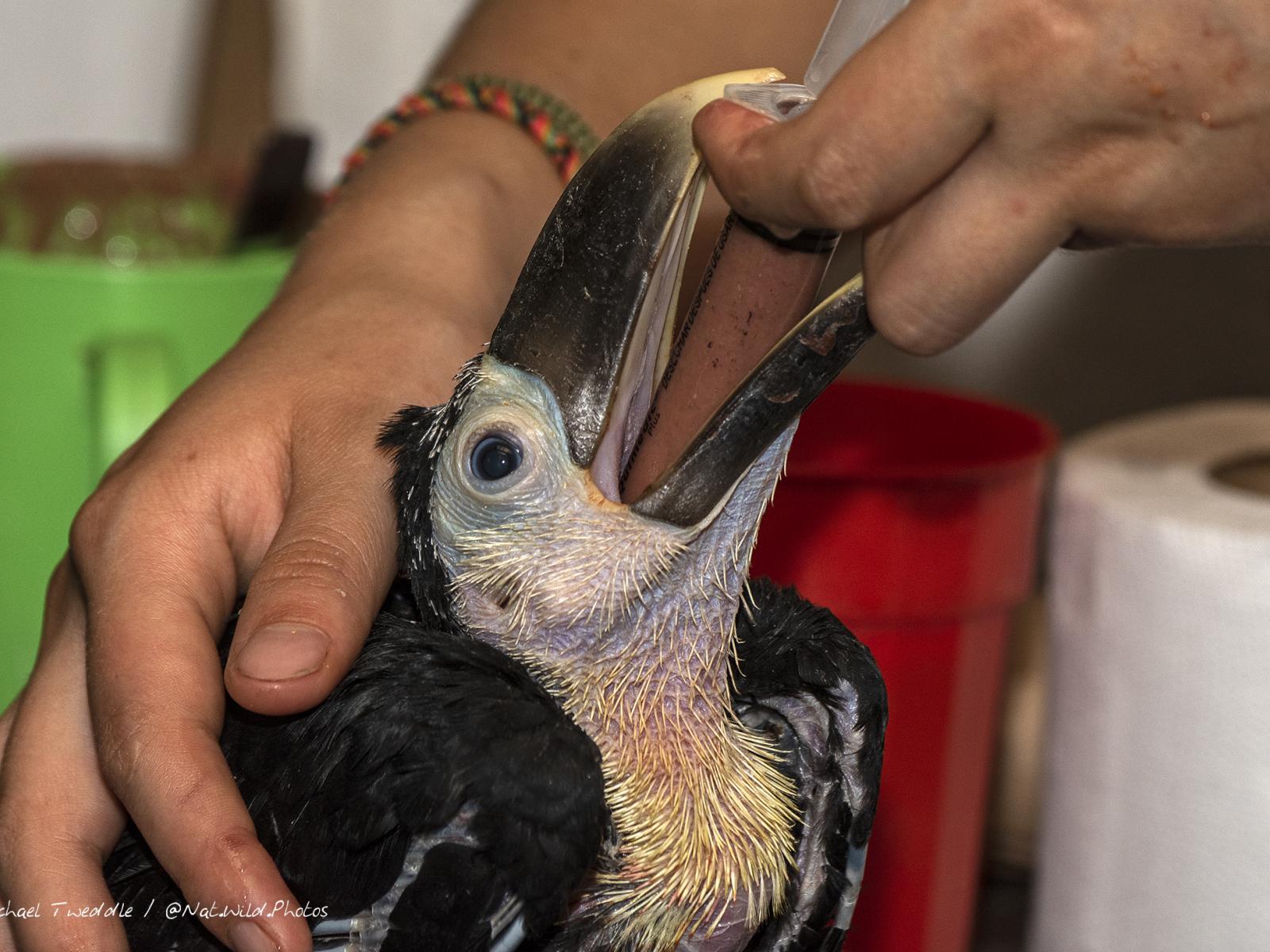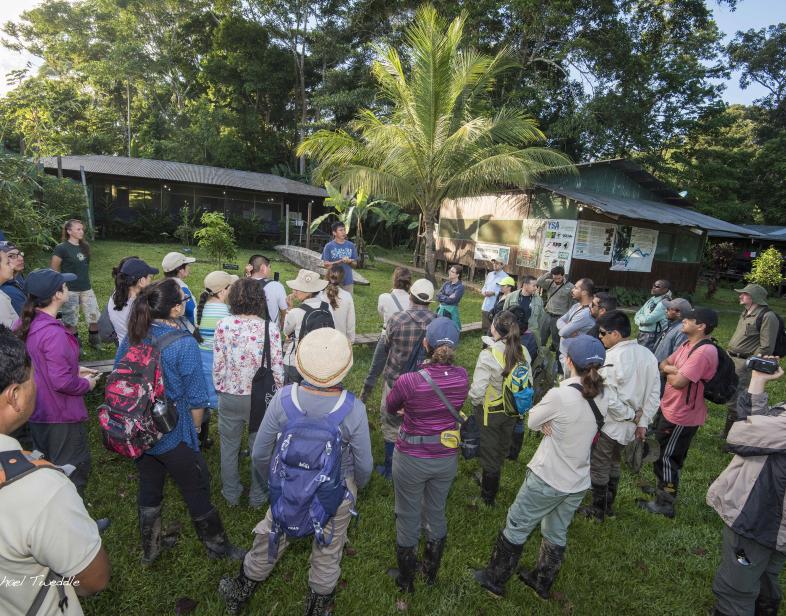An Overview Of Our Solution
Since 2008, Taricaya Rescue Center is one of the first and leading wildlife centers in Peru, putting into practice rescue and rehabilitation for effective release of wild animals, victims of illegal traficking. Under the One Health vision, the project has developed diverse and integrated programs for wildlife management, treatment, release, repopulation and reintroduction in authorized coordination with the local wildlife authority, as well as laboratory and field research, and genetic studies to secure variability. Through education with the slogan "Wild animals are not pets", TRC raises awareness about the issues of captive wildlife and trafficking, involving more and more people along the years in wildlife conservation, supporting others to replicate the project, either independently or in collaboration to expand the area of influence and streghten the network
- Population Impacted: 35000
- Continent: South America
Prénom
Nom de famille
Type d'organisation
Courriel
Analyse du contexte
Wildlife trafficking is the third ilegal industry in Peru pushed by national and international consumers. 9 of every 10 captured animals, will die during transport, some that survive end up in the hands of the buyer and others are seized by the authorities. Between 4,000 and 5,000 specimens of protected fauna are rescued alive every year in the country by SERFOR. The seized animals, the ones that survive, need a new home. Supporting the rescue, rehabilitation and release back into the wild of these victims is a key part of the solution to wildlife trafficking supporting wildlife restoration.
In Madre de Dios, economic activities like logging, goldmining, slash and burn agriculture, contribute to the deterioration of the forest ecosystem and offer easier access to capture wild animals. Many local people are not aware of the wildlife situation and the negative impact that its abuse has on the health of the forest and their own. Plus, peruvian law does allow the consumption or use of animals for subsistence purposes for native and riverside communities. Some use this context to develop the ilegal activity and it is a challenge to get people to understand the problem and in many cases to make them realize they are part of it. There is a great need to raise awareness and educate the local population about this problem. To create a stronger community that will want to join the already many conservation and responsible ecotouristic ventures. These are also economic activities in the region connected to protected areas than can support solutions to wildlife trafficking.
Taricaya Rescue center is one of the main projects developed at Taricaya Ecoreserve (Reserva Ecologica Taricaya), guardian of 476 ha of primary and secondary rainforest within the buffer zone of the Tambopata National Reserve and connected to it. With 20 years of passionate dedication to work towards wildlife conservation Taricaya has created an action network educating and raising awareness in the region.
Décrivez la solution technique que vous voudriez voir le public cible adopter.
Taricaya Rescue Center is one of these much needed places that rescued animals from wildlife trafficking can call home. Most of them after a rehabilitation process are released back into their natural habitat for a second chance at life in the wild. Some stay as residents given a great quality of life in captivity as they are not able to live independently on their own in the wild. The professional top technical scientific and heart centered work based on years of combined experience and team effort at Taricaya, the programs, the story of each animal, offer a unique educational and transformational journey experience to raise awareness and awaken the consciousness of visitors, participants, collaborators, visionaries to not only understand the problem affecting wildlife but to become part of the solution. By example of doing, we have shown that our technical solution works and has led others to adopt/improve theirs, and to local groups that free wildlife is key for a healthy ecosystem.
Décrivez votre intervention comportementale.
Since 20 years, our participatory approach and knowledge/experience exchange with different perspectives and backgrounds, applying a diversity of combined techniques and methodologies, has supported the consolidation and recognition of our work in the region. With open hearts we have alway opened our doors to people to learn, experience and join in the work we do here. People with different intentions/backgrounds (local visitors, national/international volunteers and tourists, schools, universities, pregraduate/post graduate students, researchers, guests looking to learn about the techniques, goverment authorities, etc.) have joined. They became in some way part of our efforts, allowing them to truly feel the mission and follow it in some way adopting the behaviour of respect for wildlife and/or replicate or create something on their own. Our work in the region, has promoted a more conscious action for wildlife conservation. Today, we are part of a network of 3 rescue centers working hands on with the Regional Widlife authorities, to rescue, rehabilitate and release wildlife, teaching the local population about the consequences of wildlife in captivity, the risks to their health and to the forest', the campaigns againts wildlife trafficking "Wild animals are not pets" have helped to raise more awareness and bring donatios to the center to support the animals in rehabilitation process por release.https://www.sciencedirect.com/science/article/abs/pii/S1617138114001125
Leviers comportementaux utilisés
Au besoin, veuillez expliquer comment vous avez utilisé le ou les leviers avec plus de détails.
To the public, the information of our work and results is presented to appeal to their emotions by sharing the story of each animal we rescued, to relate to the individual and understand how wildlife trafficking is a problem and wild animals are not pets. With the people that come to volunteer or work with us the social influences based on admiration to our team, passionate leaders saving wildlife, opens their willingness to collaborate and share their experience when they go home or encourages them to follow our path and directly support wildlife conservation. Rules & Regulations about what is legal and what is not regarding wildlife management and inforcing the law giving the right information that teaches and explains with an emotional message has helped us together with the local goverment to complete seizures and rescue animal in a succesfull order. In many cases people are unaware of their part in the illegal trade and these levers connected have helped us to educate them.
Décrivez votre mise en œuvre.
Forest patrol of 500ha under our protection connected to the Tambopata National Reserve to prevent invaders, illegal logging and hunting. Wildlife monitoring through diverse methodologies to assess the conservation status of the forest we protect. Animal husbandry and rehabilitation of individuals who are rescued from captivity or seizures. Release of those who can be independent again. Repopulation of Taricaya river turtle. Reintroduction of black spider monkey (first successful program of its type in Peru). Agroforestry. Education campaigns in Puerto Maldonado to raise awareness about wildlife conservation and illegal trade. By sharing and showing our solution along these 20 years and creating a network with other organizations who have replicated or followed our mission, we have helped the government to be more active in the fight against wildlife trade, we have helped more local people to understand the problem and become part of the solution, every year we receive more contacts of people in the city reaching out to ask for help to rescue an animal they see in captivity for example. We also receive visitors who were inspired by our passion and work to create documentaries, films, news reporting, thesis, projects in other parts of Peru and around the world. Conditions that enabled our work to strengthen included reinforcements of the forestry & wildlife laws and the animal cruelty law in Peru, with the government launching a strong campaign of awareness about illegal wildlife trafficking and that buying wildlife makes you an accomplice to the crime. Key success factors have been our dedication, research-action knowledge-sharing approach, our adaptation and resilience, building bridges of collaboration and support with other groups, organizations, companies, government institutions and allowed us to withstand the obstacles as floods, burocracy and curruption, the pandemic, country issues.
Décrivez le leadership de votre solution. Qui dirige la mise en œuvre?
The heart of our solution is the founder of Taricaya Ecoreserve, entrepreneur and visionary, Fernando Rosemberg, who 35 years ago saw that conservation actions for wildlife where scarce or isolated. After moving through all Madre de Dios he came up with the idea to open a space to help others help nature and Taricaya was born. Since then and now the team leading the project, people who has participated and joined our work, has included people from different parts of Peru, countries, cultures, backgrounds, professions, life experiences, livelihoods, ages. This has lead to successful planing and implementation, with a participatory approach that allows different perspectives and creativity to develop the actions and work on solutions based on trial and error, learning from experience and continued improvement based on results.
Principaux intervenants et partenaires du programme
Our efforts have consolidated key partners in: the conservation sector with Kawsay Biological Station, Hoja nueva and Amazon Shelter, organizations in the region that are part of our action network. ADI and the San Diego zoo helping us with funding. The travel/tourism sector with Amazon Planet Peru and other ecolodges in the region that promote our solution as an experience of learning from nature, Projects Abroad and other international voluntourism companies promoting our efforts as a life experience of hands on conservation in the Amazon. The education sector: Students in field trips, Interns, Pre and pots graduate researchers from universities in Madre de Dios, Lima, Cusco, Arequipa and other parts of Peru and from abroad come to learn and collab in our efforts. High school field trips with local schools as well. The goverment body in charge of forestry and wildlife management at regional and national levels (SERFOR) that after lots of hard work, we have acchieved to work hand in hand with them under the laws and rules avoiding burocratic processes and loopholes to acchieve goals of successful rescue, rehabilitation and release of wild animals and even helping them to define practical guides for proper wildlife management for several species. The goverment body in charge of natural protected areas (SERNANP), specifically of the Tambopata National Reserve, which our reserve limits with, is key for our programs to be successful in release within the area with their approval, as well as together we have become safe corridor for wildlife. The media in Peru and abroad that has registered our efforts and shared our message to Peru and the world through films, documentaries, news reports, TV shows.
Qui a adopté le(s) comportement(s) souhaité(s) et dans quelle mesure?
One key desired behaviour adopted was the commitment of more individuals/groups in the region to invest in solutions for wildlife. We were the first rescue center of its kind in Madre de Dios, now there are 2 other official ones, working together with us. A biological station protecting 200ha next to us, monitors the reintroduced spider monkeys and a 20ha private conservation area across the river works mainly with herpetofauna were created based on our solution. We have seen and supported many other iniciatives to grow in the region. The government in charge of wildlife in the region also adopted our desired behaviour. They work now more hands on with our help in th field to seize and rescue wild animals, close illegal and informal centers, use our methods to set parameters for animal husbandry and rehab for release, to raise awareness in the national and local population. The general public more and more engaging with our work by donating and sharing our solution.
Quel a été votre impact sur la pollution de l'eau?
Directly connected to the Tambopata National Reserve we safely rewild the forest supporting ecosystem restoration. We patrol primary/secondary forest through our trail system within our 550ha. Every year we collect data in different stations throughout the reserve of the different animal groups as indicators of ecosystem health and for proper animal release. For birds, 3 methods: (1) fix point observations to study bird behavior, numbers and climate; (2) mist nets for bird banding to study population dynamics, impact and seasonality of migrants, behavioral traits and much more; (3) opportunistic sightings. For herpetofauna, we use pitfall traps, night walks and opportunistic encounters. For mammals, trail census for population abundance, tracks/scats search for presence-absence. Claylicks have been identified for monitoring. For rodents and marsupials studies using Sherman,Tomahawk, pitfall traps. For bats, species mist nets to study identification and habitat use.
Quel a été l'impact de votre solution sur les problèmes d'équité?
Since we started our work we have worked with local people, giving direct jobs with just pay and social benefits to low income families, teaching techniques and start up funding for them to develop a more sustainable activity, like agroforestry to farmers. We have supported the Ese-Eja indigenous community of Palma Real, working with the leaders of the community in applying new techniques to manage their resources more sustainably and reduce manual hard work and effort times. With the women of the community we have heloed them to promote and sell their artwork, which is a main economic income for their families. With the teachers, children and teenagers of the school in the community, we replicated the repopulation of Taricaya river turtle project, teaching them about the important of this species and its conservation. Also waste management project to teach about the importance of separation and the 3R reduce, reuse, recycle.
Quels étaient les avantages sociaux ou communautaires de votre solution?
Some examples: in our Taricaya turtle repopulation project, involving Ese-Eja natives of Palma Real, we learned from them how to find nests in the beaches to save them from poachers and they learned from us to create their own artificial beach to reduce poaching and contribute to the species conservation. Another is our improved communication and coordination with the government authorities allowing us and the other rescue centers we work in collab to connect efforts from efficiently.
Quels ont été les avantages connexes de votre solution par rapport au développement durable?
Some examples: Our neighbors, developed sustainable activities inspired by us, established as allies to our cause, together we protect more land and when we grow in our efforts they are also able to grow in their work and benefits, as our activities are connected. During the pandemic and 2021 flood, our sustainability to the crisis was possible due to the key collaboration we had with our neighbors and other groups by exchanging resources and support as needed.
Durabilité : Décrivez la durabilité économique de votre solution.
For 20 years, funding was mainly from revenue of travel/tourism markets, partner companies send volunteers paying to stay with us to be part of our daily work, partner companies send visitors to experience the Amazon & learn about our conservation efforts. Other funding has come from private sector funding, ADI (since 8 years ago) as sponsor of some resident animals at the center and San Diego zoo (since 2 years ago) as donation due to the catastrophic effects of the pandemic and 2021 flood. 2020 and 2021, travel was non, since last year is recovering slowly, so we applied to a government fund that helped us, as well as donations from the general public who believe in our solution and helped us maintain it these times of crisis.
Retour sur investissement : Combien a coûté la mise en œuvre de ces activités?
The entire solution implemented from scratch 20 years ago cost about US$ 3M during the 2 decades from which almost half of the cost was directly for implementing and maintaining the wild animal rescue center. All revenue has always been reinvested on a yearly basis improving and expanding the solution to grow to what it is now. Return on investment in terms of results have been and are high. The team's livelohood with a safe just job is secured, neighboring groups and communities have more income due to our solution, thousands of wild animals have gone back successfully to their home rewilding the ecosystem, investment in wildlife conservation has increased greatly due to our example developing a sustainable economy for many in the region.
Comment pourrions-nous reproduire cette solution ailleurs avec succès?
It has been replicated in many way already in other parts of Madre de Dios and Peru at similar or smaller scales. To replicate it at a bigger scale, you can start by creating an official live network connecting the existing solutions to each other for knowledge/experience, data transfer and feedback, securing sustained exchange of resources (professionals, training, materials, funding, etc.) and results, then creating more solutions in areas where non have been implemented yet and connect them to the network too. You can follow our technique at similar scale and cost as detailed above, collaborating with key groups from all areas (sustainable businesses, non profit organizations, goverment institutions, education organizations, general public, the media, etc). An most importantly, you can make sure that the problem and our solution are first in the agenda of international groups from the global North to support the global South in Latin America towards a strong push to saving wildlife.
Thèmes liés au trafic d'espèces sauvages au Pérou
Régions péruviennes applicables
Décrivez comment la solution technique s'attaque au trafic d'espèces sauvages en Amazonie péruvienne.
Our technical solution is the development of programs that involve conservation of wildlife populations and individual wild animal welfare. This directly addresses the problem of wildlife trafficking as the animals that we rescue and rehabilitate are victims of this trade. Our work is shared and used to raise public and government awareness, and we work together with the local authorities to reinforce control and fiscalization to protect the wildlife. Under the 500ha of rainforest protected by our organization, we promote conservation areas, develop research and projects for sustainable management of resources. All this also contributes to reducing wildlife trafficking as we work with local communities and give them alternative lifelihoods that can deter them from following the wildlife trade option for income. Most importantly our solution is returning healthy rescued animals responsibly to the wild within protected areas to support rewilding and restoration of the natural ecosystem
Décrivez la pérennité et l'évolutivité de votre solution technique
Our sustainability is based on a collaborate research-action approach, with improved and innovative techniques for a multi functional project of conservation of wildlife populations, individual wild animal rescue, rehabilitation and release, repopulation and reintroduction of endangered species, agroforestry, ecotourism and voluntourism, on going over 20 years with amazing results. Scaling up our solution is possible and achievable at continental levels and can be applied to other ecosystems.
Le cas échéant, expliquez le niveau d'avancement de la solution
The solution is an ever on going research, lab and field actions to continually collect data that improves the methods and expands the positive results to support wildlife conservation, rescue and release wild animals coming from illegal trade and raise awareness to the local population. Forest patrol and surveillance is also a key action to prevent illegal activities within the 500ha protected by Taricaya and neighboring collaborators from illegal logging and hunting. One new phase at the moment is assiting in genetic testing of the San Diego Zoo project, to study the genetic variability of the animals being released back into the wild and ensure a responsible rewilding of local populations. Another is improving and expanding the facilities, equipments and professional staff of the rescue center to have more capacity and improve animal husbandry, veterinaty clinical hospital, pre-release rehabilitation and post-release monitoring. As well as scaling up the project to other areas and the education campaigns to raise awareness about wildlife illegal traffiking and the importance of its conservation for the forest's and humanity's wellbeing.
Quelles sont les sources de financement supplémentaires pour la solution ?
Funding is mainly from selling ecotourism and voluntourism activities within the Taricaya Ecoreserve. One recurrent sponsor, Animal Defenders International ADI, gives US$1000/month to the rescue center and the San Diego Zoo, with 16,000 in 2 years,
The monthly investment of running the entire project is US$ 15,000 and just the animal rescue center is US$ 8,400.
The pandemic really hit us hard as everyone around the world, but in our specific case we depend mainly on the travel and tourism market and this is the one sector that has not recovered fully compared to other industries. The project was hanging by a thread as funding was very limited but the entire solution was able to survive thanks to our donation campaigns. Organizations and the general public connected and believed in our work. Despite the obstacles today like the social unrest in Peru and Madre de Dios, travel and tourism is coming back little by little and we know we are here for the long run.
Coût de la solution innovante
This is an innovative solution that is currently active and implemented in the region. Below are the detailed costs for it to be able to fully operate and continue with the succeful growing results achieved year after year since its conception in 2001. The monthly cost of the solution is US$ 15,000 and just the animal rescue center is US$ 8,400. Breakdown costs: Salary of staff (9) leading the project activities US$4200. Human food and board $1500. Animal food and care (for about 80 individual in husbandry and rehab process) US$6000. Animal medicine and vitamins US$800. Animal lab analysis US$600. General maintenance of rescue center facilities US$1000. Administrative costs US$500. Education campaigns and marketing US$400








